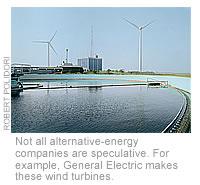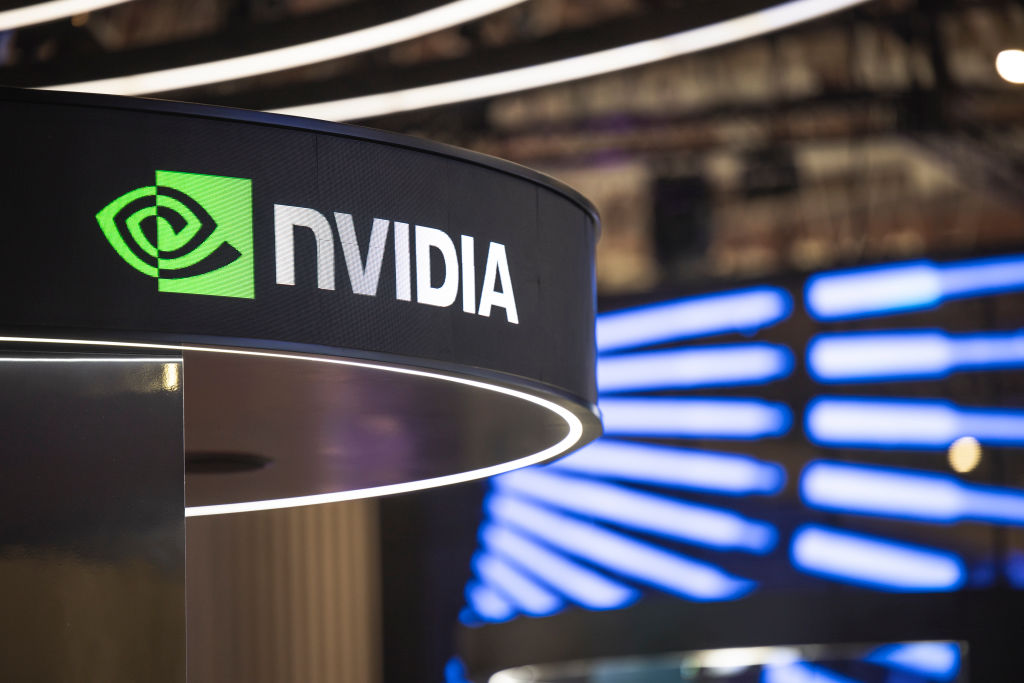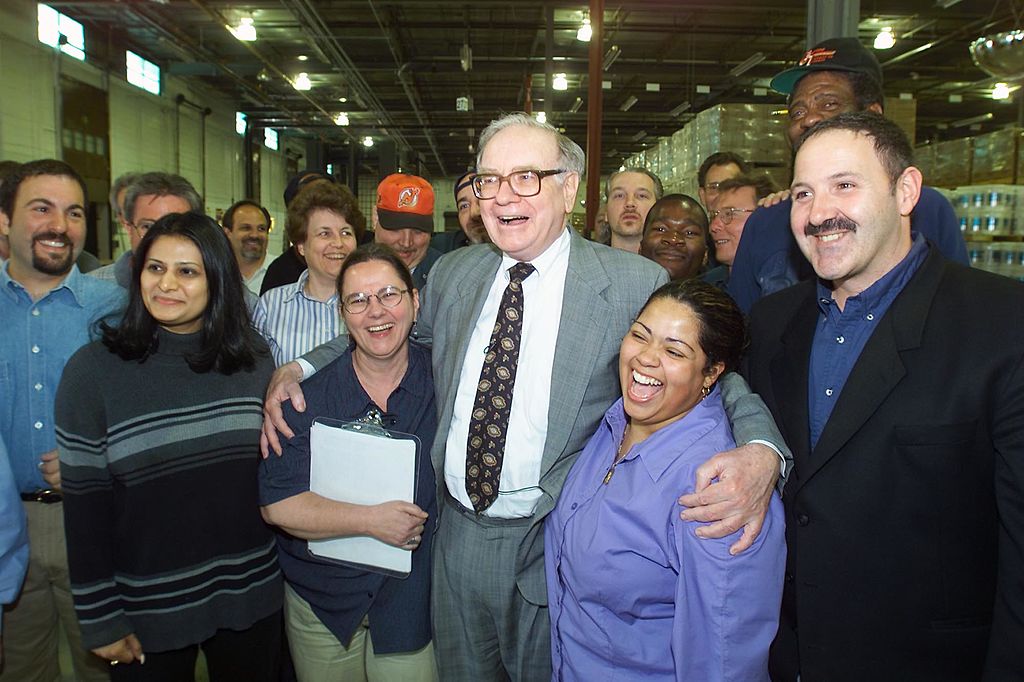25 Stocks to Invest in a Cleaner World
Not all greentech is speculative. We've identified solid companies that should profit big from addressing climate change and encouraging the use of alternative fuels. And you'll profit, too.
Five Green Up-And-ComersGreen Investing is the Next Big Thing
Meanwhile, the focus on global warming promises to lead to greater regulation of greenhouse-gas emissions. Already, the European Union has instituted a quota for carbon emissions in response to the Kyoto Protocol, a global treaty that went into effect in 2005. The U.S. did not sign the treaty, but a number of states are acting on their own to limit these pollutants. In addition, Congress passed an energy bill in 2005 that offers subsidies for various new energy technologies, and it is considering another bill this year.

Clearly, these trends will produce stock-market winners and losers, but not all of them are obvious. Makers of wind turbines and biofuels will surely benefit. But so will makers of rail cars and auto-emissions controls.
From just $107.88 $24.99 for Kiplinger Personal Finance
Be a smarter, better informed investor.

Sign up for Kiplinger’s Free Newsletters
Profit and prosper with the best of expert advice on investing, taxes, retirement, personal finance and more - straight to your e-mail.
Profit and prosper with the best of expert advice - straight to your e-mail.
We've sifted through the implications and put together the Kiplinger Green 25, a list of companies we believe will get a big boost from the growing focus on climate change and the move toward alternative fuels. Our picks vary widely in size, and four are based overseas. Some of the stocks may be expensive, and shares of some of the smaller companies may be volatile. But we think all will do well over the long term. In addition, check out our separate profiles of five up-and-comers -- small (with market values of less than $1 billion), more-speculative companies that someday could grow into green giants.

ABB
One obvious solution to the global energy crunch is simply to use less energy. Companies that can help us become more energy-efficient will find their products and services in great demand. Switzerland-based ABB is expected to produce annual earnings gains of 25% over the next few years, largely because of strong sales of power-transmission equipment that reduces energy losses between power plant and end-user, and industrial-automation equipment, such as high-efficiency motors and robotics. The power-transmission business, which accounts for half of ABB's sales, should be particularly strong as emerging countries add new infrastructure and as developed nations, such as the U.S., replace aging, outage-prone systems.

AMERICAN INTERNATIONAL GROUP
A dense thicket of environmental laws and regulations has grown to cover such obvious targets as producers of chemicals and hazardous wastes. The rules now also apply to businesses as varied as commercial real estate developers, biotechnology firms, utilities, railroads and even schools (which may store potentially hazardous materials on campus). AIG, the giant insurer, has been writing policies that protect businesses against environmental claims since the early 1980s. Such policies represented about 3% of the $31 billion in premiums from AIG's U.S. property-and-casualty business last year. But as efforts to curb greenhouse gases grow, businesses will need protection against new types of liabilities that will surely arise. AIG is also a leader in writing insurance that protects participants in the nascent global market for trading carbon credits.

AMERICAN STANDARD
This 78-year-old company is getting a makeover. American Standard spun off its vehicle-control division this summer and will finalize the sale of its bath-and-kitchen business this fall. That will allow the Piscataway, N.J., company to focus on its most lucrative division, which makes heating, ventilation and air-conditioning (HVAC) systems. Selling principally under the Trane brand, American Standard is a leader in energy-efficient air-conditioning and climate-control systems. This will be a hot industry because buildings account for one-third of global energy demand. Any solution to greenhouse-gas emissions must include drastic reductions in energy demand from office buildings, residential towers and other large structures. Warren Buffett appears to like what he sees in the new American Standard; his Berkshire Hathaway has become one of the company's biggest shareholders.

APPLIED MATERIALS
First, this important Silicon Valley technology company overcame stiff Japanese competition to emerge as the world's largest producer of capital equipment for makers of semiconductors, with $10 billion in annual revenues. Then it applied that prowess to make equipment used to manufacture LCD flat-panel displays, a process that requires similar technology. Now, Applied, based in Santa Clara, Cal., is making a strong bid to be the leading manufacturer of equipment needed to produce photovoltaic cells and film -- another process technically akin to making semiconductors. With 85% of revenues generated outside the U.S., Applied, which also makes the tools to fabricate energy-efficient glass, has the world covered.[page break]

BURLINGTON NORTHERN SANTA FE
One double-stack train can haul as much freight as 280 trucks while emitting a fraction of the pollutants and burning a fraction of the diesel fuel. As railroads burnish their environmental credentials, Burlington Northern Santa Fe should benefit the most. The Fort Worth company hauls enough low-sulfur (and relatively clean-burning) coal from Wyoming's Powder River Basin to light up 10% of the nation's homes. It also hauls more grain products than any other railroad, including both the corn used to make ethanol and the ethanol itself. In fact, Burlington Northern frequently runs 95-car ethanol trains from the Midwest to California to meet the demand created by the state's strict auto-emissions standards.

COVANTA
An alternative approach to power generation that is already commercially viable is to get it from garbage, and the leader in waste-to-energy facilities is Covanta. The company operates 32 plants that burn trash and municipal waste to make steam and heat for power generation. Trash haulers pay the Fairfield, N.J., company to take the waste off their hands. This form of renewable energy is especially competitive in places such as New England, where landfill space comes at a premium. Besides, while there may be shortages of oil and natural gas, it's hard to imagine that there will ever be a shortage of a superabundant source of renewable energy such as trash.

EXELON
Nuclear power benefits in several ways from the emerging energy picture, says Robert Becker, co-manager of Cohen & Steers Utility fund. Surging fossil-fuel prices make nuclear energy highly competitive. Emissions are low compared with those from power plants that burn coal or oil. In the future, a system of carbon-emission credits and licenses is likely to develop in the U.S., as it has in Europe. "Under any scenario in cap and trade, the clear winners will be the nuclear generators," says Becker. His favorite utility is Exelon, of Chicago, the largest operator of nuclear power plants in the U.S. Exelon generates more than 70% of its power from nuclear fuel.

FPL GROUP
More than just a big Florida utility, FPL produces about 40% of the wind-generated electricity in the U.S. It gets 19% of its power from nuclear plants, and it owns few coal-fired facilities. In the future, if government regulations further cap the amount of pollutants that power plants may emit, the Juno Beach, Fla., company will be sitting pretty. More important, as the government requires other utilities to add more power from renewable sources to their mix, FPL will have a lot of power-hungry customers for its wholesale business, which can charge whatever the market will bear.

GENERAL ELECTRIC
You can't discuss new energy technologies without mentioning General Electric. The giant conglomerate is a major producer of wind turbines and clean-coal technology, not to mention energy-efficient locomotives, jet engines, home appliances and light bulbs. The Fairfield, Conn., company estimates that revenues from its clean-energy businesses were $12 billion last year (out of $163 billion total) and predicts that the figure will rise to $20 billion by 2010. And that doesn't include $1 billion in annual revenues from GE's nuclear-energy business. GE's stock is still one-third below its high mark in August 2000.

HONDA MOTOR
Any serious attempt to reduce greenhouse gases will need to zero in on the auto industry, which is responsible for at least one-third of carbon-dioxide emissions. That's why we like Honda Motor, whose fleet of cars, including the Accord, Civic, Odyssey and Acura names, is the most fuel-efficient of any major carmaker. That means the Japanese firm will benefit from tighter U.S. fuel-economy standards. The Civic Hybrid, for example, gets up to 45 miles per gallon. (Toyota Motors is the leader in hybrid vehicles, but Honda's shares are priced more attractively.) When the U.S. government mandates tighter fuel-economy standards, Honda will be off to the races.

INTERNATIONAL RECTIFIER
Lighting is an energy hog. The International Energy Agency estimates that lighting accounts for 19% of the world's electricity consumption. The best way to address this insatiable demand is to replace the venerable incandescent light bulb with newer, more energy-efficient technologies, such as compact fluorescent bulbs and light-emitting diodes (LEDs), a technology that cuts electricity consumption by more than 80%. International Rectifier makes the semiconductor power-conversion devices, called ballast controllers, for both types of lighting. The El Segundo, Cal., company makes a broad range of energy-conserving power-management chips for cars, appliances, computers, aircraft and factories. Because so much manufacturing has moved abroad, International Rectifier books three-fourths of its sales overseas. (Note: IR is investigating accounting irregularities at one of its foreign units.)

ITRON
Variable rates for home electricity use are coming. A 2005 federal law requires utilities to look into ways to spread out electricity demand (and reduce the need for new generating stations) by charging more for power used during peak hours. A key player in this market is Itron, the leading U.S. supplier of electricity meters (and a leader in gas and water meters as well). Its 50% market share for "smart" electric meters that can be read automatically puts it in a good position to help utilities put time-based pricing in place. Shares of the Liberty Lake, Wash., company have nearly doubled in the past year, but the opportunity is big. Just 5% of the world's electric, water and gas meters use smart meter-reading technology.

JOHNSON CONTROLS
It invented the room thermostat in the 19th century, and Johnson Controls is still going strong. As the leading worldwide supplier of temperature controls to the heating, ventilation and air-conditioning industry, Johnson is still at work making buildings more energy-efficient. It's also a leading supplier of HVAC systems. But the Milwaukee company's largest business is making automotive products. It supplies long-life lithium-ion batteries for hybrid vehicles, such as GM's Saturn Vue Green Line sport utility vehicle.

MCDERMOTT INTERNATIONAL
The U.S. leans on its plentiful but dirty coal reserves for half of its electricity generation. So coal's not going away anytime soon -- far from it. The solution is to clean up the coal. McDermott International's Babcock & Wilcox division has cutting-edge technology for scrubbers that capture harmful coal emissions before they are released into the atmosphere. So McDermott stands to gain as environmental regulations mandate retrofits and upgrades to existing coal-fired plants. This Houston-based engineering-and-construction company is also a leading supplier to the nuclear industry.[page break]

MEMC ELECTRONIC MATERIALS
One factor restraining the growth of solar power has been the shortage (and soaring prices) of silicon wafers, the key material from which solar cells are fabricated. That's been a boon for MEMC Electronic Materials, the leading U.S. maker of silicon wafers, which has almost tripled its earnings in two years. This hard-to-make substance is the same material used for making semiconductors. But while the chip industry seeks smaller and smaller products, the solar-power industry wants large panels that cover rooftops. Edward Guinness, co-manager of Guinness Atkinson Alternative Energy fund, calculates that it costs MEMC $27 per kilogram to produce silicon wafers, which it sells for $180 to $300 per kilo. Not a bad business.

ORMAT TECHNOLOGIES
Geothermal power is a renewable energy technology that is not dependent on weather (as wind and solar are) and is thus more reliable. The technology uses hot water and steam from deep underground to turn a turbine and generate electricity. Ormat Technologies is the third-largest geothermal firm in the U.S. and the only one of the top three that focuses exclusively on geothermal power. Its shares are pricey, but the Reno, Nev., company stands to benefit from government mandates in California and Nevada (where most of its U.S. plants are located) that require utilities to buy more power from renewable sources.

PHILIPS ELECTRONICS
Philips Electronics of the Netherlands is such a sprawling consumer-electronics giant (2006 sales: $36 billion) that people forget it's the world's leading maker of incandescent light bulbs. But unlike most entrenched industry leaders, Philips isn't averse to jettisoning the old and adopting new technologies. Jens Peers, lead manager of Calvert Global Alternative Energy, says Philips is making an aggressive bid to capture the premier position in new, energy-efficient lighting, such as LED and compact fluorescent bulbs. In pursuit of this goal, Philips has been acquiring lighting companies with advanced technology, such as Color Kinetics, an LED fixture maker in Boston.

ROHM & HAAS
Air pollution can come from some surprising sources, such as house paints, which, years after their application, continue to release low levels of toxins into the air. Philadelphia-based Rohm & Haas, a maker of coatings, sealants and other specialty materials, gets 70% of its revenues from environmentally friendly products, such as water-based paints, formaldehyde-free insulation and lead-free electronics products. "It's a green company in disguise," says Todd Ahlsten, manager of Parnassus Equity Income fund, who holds Rohm & Haas in his fund.

SHAW GROUP
A growing number of people in developing countries now have the means to heat and cool their homes and businesses. That portends a huge increase in spending on power-plant construction -- as much as $5.2 trillion through 2030, according to the International Energy Agency. Shaw Group, an engineering-and-construction firm headquartered in Baton Rouge, La., has a 20% stake in Westinghouse Nuclear and is a major player in both building new coal plants and making older ones burn more cleanly. Bad accounting decisions have plagued the shares recently, but an $11-billion backlog of business, mostly from planned power plants, should lead to a brighter future.

SUNPOWER
The demand for solar cells and panels is booming. The question is whose technology will prevail in the youthful industry. Kevin Landis, manager of Firsthand Technology Value, thinks San Jose, Cal.-based SunPower will be a winner. SunPower makes the solar-power industry's most energy-efficient panels, measured by the conversion of sunlight into electricity (the efficiency of its solar cells is more than 20%, which is 50% higher than that of conventional cells). SunPower, which is 53%-owned by Cypress Semiconductor, derives all of its revenues from solar-related products.

SUNTECH POWER HOLDINGS
The enormous potential of solar energy is no secret, and that's why the stocks of so many firms in this field are expensive. One company that may nevertheless pay off is Suntech Power Holdings. China's largest maker of photovoltaic cells, which convert sunlight to energy, has the scale to produce low-cost, high-profit solar equipment for sale in the international market. The firm is profitable, and earnings should grow 25% to 30% annually over the next few years, says fund manager Guinness.

TENNECO
Over the next eight years, stricter auto-emissions standards will take effect in Brazil, China, India, Japan, Russia, the U.S. and Western Europe. That's good news for auto-parts supplier Tenneco, which gets nearly two-thirds of its revenues from emissions equipment (the rest comes from suspension gear). It is the leading supplier in China and Europe, and it is number two in the U.S. The Lake Forest, Ill., firm is especially well positioned to sell emissions equipment for diesel-powered cars and trucks, which offer better fuel efficiency than gasoline-powered models do.

TRINITY INDUSTRIES
Another way to play the boost in railroads' fortunes is via Trinity Industries, the nation's largest manufacturer of railcars. Demand for covered hopper cars, which carry grain, as well as for coal cars and tank cars for hauling ethanol, contributed to a record order backlog of almost 34,000 cars at the end of the second quarter. The Dallas-based manufacturer is also a backdoor play on wind power, as it is a leading maker of towers for wind-powered turbines. Trinity's energy division, which includes the wind towers and other businesses, makes up only 11% of revenues. But wind-tower revenues, driven by federal tax breaks, could soar to as high as $250 million this year, up from $11 million in 2004.

UNITED TECHNOLOGIES
This splendidly run industrial conglomerate focuses on energy conservation both within the company and with the products it sells. Its Otis elevator and Carrier heating and air-conditioning units are developing more energy-efficient systems. The Hartford, Conn., company also makes fuel cells for buildings, transit buses and the U.S. space program. Also the maker of Pratt & Whitney engines and Sikorsky helicopters, United has been riding the global boom in infrastructure building.

ZOLTEK
These are boom times for makers of carbon fiber, a strong, lightweight material used to make aircraft parts as well as the 175- to 200-foot-long blades that turn wind turbines. Zoltek supplies both markets, and its stock has more than doubled in the past year as demand from both sources has soared. But this may be only the beginning. Zoltek chief executive Zsolt Rumy thinks carbon fiber will soon be used to make lightweight, fuel-efficient cars; precast-concrete structures; and ultra-deep-sea oil-drilling equipment. He expects worldwide carbon-fiber production to more than double by 2010, to $2 billion, and thinks his own company's sales can hit $500 million in 2011, more than five times higher than last year's total.
Profit and prosper with the best of Kiplinger's advice on investing, taxes, retirement, personal finance and much more. Delivered daily. Enter your email in the box and click Sign Me Up.
-
 Dow, S&P 500 Slip on December Rate Cut Worries, Nvidia Boosts Nasdaq: Stock Market Today
Dow, S&P 500 Slip on December Rate Cut Worries, Nvidia Boosts Nasdaq: Stock Market TodayNvidia became the first company ever to boast a $5 trillion market cap, but it wasn't enough to lift the Dow and the S&P 500.
-
 Where You Choose to Stash $100k Now Comes with a Big Opportunity Cost
Where You Choose to Stash $100k Now Comes with a Big Opportunity CostThe Fed recently cut rates. Here's where to maximize your savings while rates remain higher.
-
 What the Rich Know About Investing That You Don't
What the Rich Know About Investing That You Don'tPeople like Warren Buffett become people like Warren Buffett by following basic rules and being disciplined. Here's how to accumulate real wealth.
-
 How to Invest for Rising Data Integrity Risk
How to Invest for Rising Data Integrity RiskAmid a broad assault on venerable institutions, President Trump has targeted agencies responsible for data critical to markets. How should investors respond?
-
 What Tariffs Mean for Your Sector Exposure
What Tariffs Mean for Your Sector ExposureNew, higher and changing tariffs will ripple through the economy and into share prices for many quarters to come.
-
 How to Invest for Fall Rate Cuts by the Fed
How to Invest for Fall Rate Cuts by the FedThe probability the Fed cuts interest rates by 25 basis points in October is now greater than 90%.
-
 Are Buffett and Berkshire About to Bail on Kraft Heinz Stock?
Are Buffett and Berkshire About to Bail on Kraft Heinz Stock?Warren Buffett and Berkshire Hathaway own a lot of Kraft Heinz stock, so what happens when they decide to sell KHC?
-
 How the Stock Market Performed in the First 6 Months of Trump's Second Term
How the Stock Market Performed in the First 6 Months of Trump's Second TermSix months after President Donald Trump's inauguration, take a look at how the stock market has performed.
-
 Fed Leaves Rates Unchanged: What the Experts Are Saying
Fed Leaves Rates Unchanged: What the Experts Are SayingFederal Reserve As widely expected, the Federal Open Market Committee took a 'wait-and-see' approach toward borrowing costs.
-
 Fed Sees Fewer Rate Cuts in 2025: What the Experts Are Saying
Fed Sees Fewer Rate Cuts in 2025: What the Experts Are SayingFederal Reserve The Federal Reserve cut interest rates as expected, but the future path of borrowing costs became more opaque.